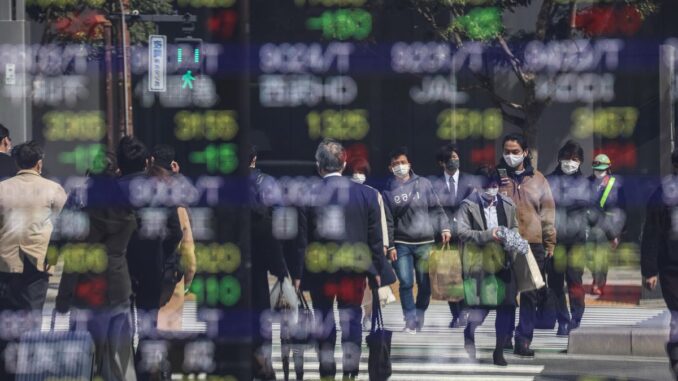
Tesla. Bitcoin. GameStop. U.S. Treasury bonds. In every single place traders look nowadays, they discover history-making bubbles staring again at them.
The generally cited offender is central banks refilling the proverbial punchbowls too typically and too liberally. An excessive amount of financial liquidity chasing too few good bets is all the time and in every single place a recipe for runaway froth.
That is the why regarding this bubble in bubbles. Extra consideration, although, needs to be on how we bought right here. And which means Tokyo.
A cross highway is being mirrored by an digital board displaying Japans Nikkei 225 index and different … [+]
Stanislav Kogiku/SOPA Photos/LightRocket through Getty Photos
Sure, the Federal Reserve is the globe’s premier bubble blower as 2021 heats up. Extreme credit score from the central financial institution of the largest financial system that prints the reserve forex will all the time carry essentially the most weight with markets, and for legitimate causes.
Final week, although, Fed Chairman Jerome Powell admitted what so many economists assured us may by no means occur: It’s trapped at zero rate of interest indefinitely with the Financial institution of Japan. Powell did his finest to not say that, precisely. However he is aware of higher than anybody that when the Fed says it’ll be at zero till 2023, he may as properly admit it may very well be 2033—or properly past.
Former BOJ Governor Toshihiko Fukui understands how Japan—and now the U.S.—bought right here higher than simply about anybody.

Former Financial institution of Japan Governor Toshihiko Fukui spoke throughout a press convention in 2007.
AP Photograph/Itsuo Inouye
Fukui’s 2003-2008 tenure noticed the BOJ attempt its hand at charge normalization. When Fukui grabbed the reins from predecessor Masaru Hayami, the BOJ was 4 years into its experiment with zero charges and two years into its quantitative easing period. First, Fukui ended QE. By 2006, the Fukui’s workforce pulled off the primary of two 25 basis-point charge hikes.
The empire was fast to strike again. Instantly, lawmakers, CEOs, bankers and traders blamed Fukui’s brake-tapping strikes for mushy demand throughout the financial system. By 2008, the primary transfer by Fukui’s successor, Masaaki Shirakawa, was to chop charges again to zero.
The official excuse was fallout from the “Lehman shock,” however actually it was Japan Inc.’s habit to free cash. With out realizing it, the company and political institutions bought so used to zero charges. It grew to become a vital ingredient for achievement. As borrowing prices disappeared, crushing public and company money owed appeared much less burdensome. Banks grew to get pleasure from low-cost credit score and the impact zero-to-negative yields had on stability sheets.
Ultraloose BOJ insurance policies, meantime, took the onus off elected officers to implement destabilizing reforms. They made it simpler for exporters to keep away from tough restructuring choices. They papered over cracks throughout all sectors. That fueled any variety of asset bubbles—not least of which a Nikkei 225 Common close to 30-year highs whilst Covid-19 devastates the actual financial system.

Japan’s Nikkei 225 index crossed the 30,000-point threshold for the primary time in a few years in … [+]
AP Photograph/Eugene Hoshiko
Janet Yellen has her personal model of this story. Again in late 2015, lengthy earlier than Yellen was named Treasury secretary, Yellen was operating the Fed when its raised charges for the primary time since 2006. The derision that step generated wasn’t all that completely different from what Fukui skilled years earlier.
The Yellen Fed acquired rhetorical assaults from future President Donald Trump. In February 2018, a yr into the Trump regime, Yellen was changed by Powell. He moved rapidly to slash charges again to zero and revive the QE insurance policies Yellen had dismantled. Powell, although, pushed Fed insurance policies into new uncharted territories, propelling Wall Road towards document highs.
Since Covid-19, Powell shifted the Fed into gears increased than financial economists thought had been attainable. By Could 2020, the Fed’s stability sheet swelled to $5.3 trillion, roughly equal to the BOJ’s.
The trillions of {dollars} of asset purchases added even higher gas to rallies in shares, U.S. authorities bonds, gold, cryptocurrencies, electrical automobile giants like Tesla, actual property and lots of unlikely investments—together with GameStop, Blockbuster video and different Reddit chat-room-driven rallies.

GameStop’s brand seems towards a backdrop of Reddit logos.
Pavlo Gonchar/SOPA Photos/LightRocket through Getty Photos
By going the way in which of the BOJ, the Fed is making odd speculative tangents seem to be momentum trades. The BOJ, after all, has lengthy since made the occasional pyramid scheme really feel like a successful worth funding. That can occur when a central financial institution successfully nationalizes the inventory markets by changing into a top-10 shareholder in virtually half the market through exchange-traded funds.
The Fed, although, is supersizing the technique. It’s additionally rising the percentages it will get trapped. The extra financial authorities commandeer personal markets, the extra they reward mediocrity amongst CEOs and boards. The extra you overwhelm markets with liquidity, the more durable it will likely be to plot an exit.
In 2006, Fukui thought Japan was able to reside with out a financial intravenous—simply as Yellen determined in Washington a decade later. In 2021, although, the BOJ and Fed are including much more life-support instruments to even larger IV doses. That’s fueling bubbles wherever you look as central banks go the Tokyo route.





 Bitcoin
Bitcoin  Ethereum
Ethereum  Tether
Tether  Solana
Solana  USDC
USDC  XRP
XRP  Lido Staked Ether
Lido Staked Ether  Dogecoin
Dogecoin  Toncoin
Toncoin
Be the first to comment